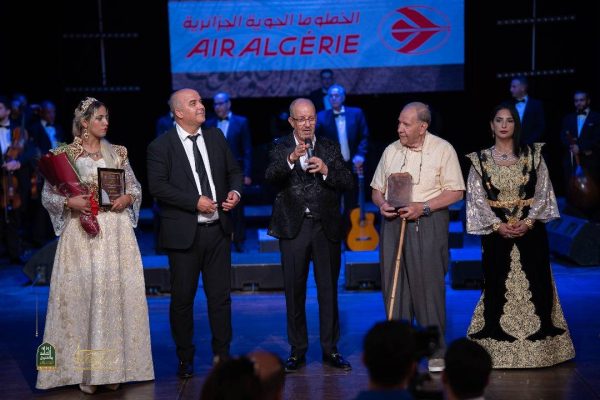Physical Address
Indirizzo: Via Mario Greco 60, Buttigliera Alta, 10090, Torino, Italy
Physical Address
Indirizzo: Via Mario Greco 60, Buttigliera Alta, 10090, Torino, Italy

Under the vaults of the Mohamed Tahar Fergani regional theater, the voices and instruments of the Malouf made vibrate, Sunday evening, an archical room, weaving a subtle link between past and present, tradition and modernity. Through deep emotions, tributes and musical flights, Algerian and international artists offered a brilliant celebration of heritage, where each note transcended the borders and touched the soul of spectators, during the second evening of the 13ᵉ International Festival of Malouf.
The evening started with Beihdja Rahal, a musician interpreter and emblematic figure of the Algerian school in Malouf. Dressed in a Gandoura Constantinoise, an elegant tribute to the city and its traditions, she opened her recital with extracts from Sika’s Nuba, including “Ya Layl Allah Ya Layl” and “Wa Kayfa Yanam al-‘chiq”. His clear and modulated voice, perfectly mastered in the Maqāmāt, navigated with fluidity between delicate passages and powerful crescendos, revealing the expressive richness and the complexity of the Algerian tradition.
Accompanied by Oud, Kamanja and light percussion, Rahal alternated between subtle and passionate flights. The golden lights, projected in a circular way on the stage, created an intimate halo, giving the impression that each spectator shared a musical secret. Nourished and spontaneous applause punctuated each movement of the voice, reflecting the admiration and complicity of the public.
The scene was then invested by Abderrachid Segni, grand master of Malouf and disciple of the legendary Mohamed Tahar Fergani. With a calm and majestic presence, he chose to interpret “Salah Bey”, also known as “Galou Laarab Galou”. This elegiac poem traces the tragic events from the end of the 18th century to Constantine and pays homage to Salah Bey, a striking historical figure whose tragic fate has deeply marked collective memory.
SEGNI plunged the room into an atmosphere of meditation where each vocal ornament, each Glissando of Kamanja or Oud seemed to tell the story of the city. The spectators accompanied the rhythm of the hands and the Zghareds, creating a living dialogue between the stage and the room. He also interpreted “Mrouhoune Bil Salama” and “Ya Mohamed Ya Sari ‘al-‘orouba”, each room wrapped in hot and dim lighting, giving the impression of being transported in a Constantine of yesteryear, between Ottoman Palace and cobbled alleys.

Andalusian merger and northern accents
The opening on the international was signed by Hind Zouari, a Tunisian musician who transformed the scene into a musical journey without borders. Tightening her Qanûn, surrounded by the Austrian violinist Irène, the Swedish cellist Mimi, and the Tunisian percussionist Amina at the Darbouka, she proposed a Malouf tinged with modernity and spirituality, accompanied by the Constantine orchestra led by Youcef Bounas.
Zouari started with “Sawt al-Mouhajer” (La Voix du Migrant), a personal composition dedicated to exiled artists, before revisiting “Al-Bint al-Shalabiya”, a classic Arab brought up to date with subtle arrangements where Qanûn, Kamanja and percussion created sometimes ethereal atmospheres.
In an intense spiritual moment, she interpreted “Talama Achkou Gharami”, merging Andalusian modes with aerial Nordic accents, proving that Malouf can dialogue with the most distant musical traditions. She then transported the public to the Southern Tunisian oases with “Dhawq al-Nakhil”, before concluding her recital in apotheosis with “Toucha al-Zidan”, the Mouachah “Ya Madh-Hala Ar-Râh” and the popular “Sidi Mansour”, taken up in chorus by a conquered and standing room. The light oscillated between purple and gold, enveloping the spectators in a unique sound and emotional bubble.
The highlight of the evening was marked by Abdelaziz Benzina, nicknamed “Le Rossignol du Malouf”. The artist interpreted emblematic pieces of the Malouf Constantinois: “And al-Bey Mansour”, “Qoudam Darak”, “Ydoum Hnakoum”, “Billahi ya Hamami”, “Ya Chadli Belhassen” and “A’chik Memhoun”.
Descending among the public, Benzina created a direct and warm interaction with the spectators. His voice, sometimes caressing, sometimes powerful, accompanied by the Oud, the Kamanja and the flute, vibrated each present soul. Applause, songs and beats of hands transformed the theater into a space of total communion, where music and emotion became a universal language.
A moving tribute was paid to Amar Touhami, an important figure in the recently disappeared Malouf Constantine. This ceremony was followed by the delivery of a symbolic trophy and a certificate of honor to his family, testifying to the deep recognition and the attachment of the city to this passionate artist. Nourished applause and spectators’ tears have confirmed the impact and scope of his work, whose imprint will remain forever engraved in the musical heritage of Constantine.
